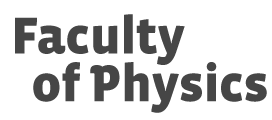Condensed Matter Physics Seminar
2006/2007 | 2007/2008 | 2008/2009 | 2009/2010 | 2010/2011 | 2011/2012 | 2012/2013 | 2013/2014 | 2014/2015 | 2015/2016 | 2016/2017 | 2017/2018 | 2018/2019 | 2019/2020 | 2020/2021 | 2021/2022 | 2022/2023 | 2023/2024 | 2024/2025
2019-11-15 (Friday)
Adam Bednorz (IFT WF UW)
Is energy conserved when nobody looks?
Conservation principles are essential to describe and quantify mechanical processes. Classically, the conservation holds objectively because the description of reality can be considered independent of observation. In quantum mechanics, however, invasive observations change quantities drastically, even those conserved classically. Interestingly, we find that the non-conservation is manifest even in weakly measured correlations if some of the observables do not commute with the conserved quantity. Our observation casts some doubt on the fundamental compatibility of conservation laws and quantum objectivity.
2019-11-08 (Friday)
Anna Maciołek (Max-Planck Stuttgart and IChF PAN Warszawa)
Current-mediated synchronization of a pair of beating non-identical flagella
The basic phenomenology of experimentally observed synchronization (i.e. a stochastic phase locking) of identical, beating flagella of a biflagellate alga is known to be captured well by a minimal model describing the dynamics of coupled, limit-cycle, noisy oscillators (known as the noisy Kuramoto model). As demonstrated experimentally, the amplitudes of the noise terms therein, which stem from fluctuations of the rotary motors, depend on the flagella length. Here we address the conceptually important question which kind of synchrony occurs if the two flagella have different lengths such that the noises acting on each of them have different amplitudes.
2019-10-18 (Friday)
Dominik Lentrodt (Max Planck Heidelberg)
Ab initio few-mode theory for open quantum systems
The concept of a single mode of the electromagnetic field interacting with matter has been a paradigm in the field of light-matter interactions. For example, the single mode Jaynes-Cummings model and its many generalizations, such as the many-body Dicke model, have been indispensable tools in studying the quantum dynamics of various systems. In particular in cavity and circuit QED, where strong light-matter coupling is routinely achieved in experiment, such models have been tremendously successful. Recently, however, various experimental platforms have emerged where multi-mode effects, complex environments and the openness of the system constitute an essential part of the physics, and where the applicability of few-mode models has been debated. In this talk, we will present "ab initio few-mode theory", where these factors are treated systematically and which allows to include new physics into Jaynes-Cummings type models without abandoning their conceptual and computational simplicity. We will outline some implications, in particular for the new field of X-ray cavity QED as well as for ultra-strong coupling theory. From a practical perspective, our method connects the extensive toolbox of few-mode models to ab initio theory. From a more general perspective, it constitutes a non-perturbative expansion scheme that allows to extract the relevant degrees of freedom of a quantum system featuring continuum interactions. As such, it may find applications in a broader context ranging from transport theory to open quantum dynamics.
2019-10-04 (Friday)
Takami Tohyama (Tokyo University of Science)
Spin and charge excitations of high-Tc cuprates as seen by resonant inelastic X-ray scattering
Resonant inelastic X-ray scattering (RIXS) is one of techniques that has developed greatly with the study of cuprate high-temperature superconductors, which is similar to angle-resolved photoelectron spectroscopy. Charge excitation within the 3dx2-y2 orbital and two-magnon excitation appear in the low energy region of the RIXS spectrum via excitation of 2p electrons in Cu to the 3d orbital by incident photons. In addition to these spin-nonflip excitations, spin-flip excitations ((para) magnon excitations) due to the spin-orbit interaction of the 2p core level are observed in Cu L-edge RIXS. In this talk, I will introduce the current status of research in cuprates using RIXS as well as the theoretical investigations of our group. In particular, I discuss recent exact diagonalization and dynamical density-matrix renormalization group (DMRG) studies on the dependence of RIXS intensity on incident X-ray energy, the difference in behavior between hole-doped and electron-doped systems, and spin excitation in stripe order in connection with recent experimental data on RIXS for cuprates.







